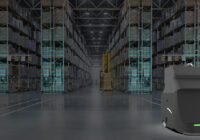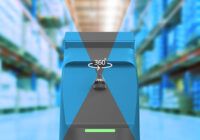Imagine a mobile robot that moves through a warehouse’s aisles and helps move things across a huge area. They have excellent path perception, allowing them to quickly and safely avoid obstacles and finish repetitive tasks with great dependability. Now picture a different breed of such advanced robots inspecting the plants and autonomously picking the ripe fruits and veggies in a greenhouse or other agricultural setting. These machines could also help with field pesticide application and crop maintenance. AMRs, or autonomous mobile robots, are robotic systems capable of navigating, detecting obstacles, and identifying items entirely autonomously.
Most of you who are reading this have either encountered these robots or are likely working on designing similar systems for use in warehouses, farms, retail establishments, and other locations. To perform their separate functions autonomously, they require “eyes” to observe and understand their surroundings. Cameras are used to complete this task.
How Autonomous Mobile Robots 3D Vision Can Boost Cobot Safety and Performance
The newest collaborative robots, also known as cobots, are designed to cooperate with human workers. Robot vision systems are frequently a crucial instrument that aids in extending the functioning of these robots.
These autonomous mobile robots are designed to be flexible. Cobots are often lightweight and simple to program, making them portable from one workplace to another. They become even more adaptable thanks to machine vision, which enables a variety of vision-guided robot (VGR) applications, such as pick-and-place, machine tending, and assembly.
Some cutting-edge systems can even pick up complex bins using machine vision. It has historically proven challenging to automate these tasks. The cobot can support human workers while they are working by using machine vision without interfering with normal workflows. The cobot can assist workers and free up human labor for other crucial duties.
Robot safety can benefit greatly from robotic vision. Cobots employ machine vision to determine safe motions that permit complicated jobs without endangering human safety, much like an AMR can use to read its environment dynamically. For instance, a cobot may employ machine vision to analyze the location of people, parts, and other machines in real time. A cobot may dynamically move its machinery, such as a robotic arm, as a human worker performs duties, assuring safe operation without slowing down production.
Why Should We Use 3D Cameras for Autonomous Mobile Robots?
The appropriate camera must be chosen to achieve the greatest results when purchasing omnidirectional 3D vision systems. DreamVu offers a variety of cameras that describe the omnidirectional 3D vision systems best suited for varied industrial settings. In diverse manufacturing circumstances where human involvement is not possible, selecting the right camera, lens, controller, and display for inspection purposes is critical. The following are a few cameras by DreamVu which are used in mobile robots as a 3D vision system,
PAL
PAL offers a 110° vertical field of view and a 360° horizontal field at up to 9 megapixels, with a decent depth range of 10 meters and no minimum depth. PAL is the ideal sensor for autonomous mobile robots (AMR) navigation systems since it can generate a detailed 3D occupancy map from each frame. PAL helps AMRs localize and move along the most direct paths by providing ODOA and SLAM with a full understanding of the surrounding terrain.
PAL USB was created and produced to adhere to the strict specifications of industrial applications. It has a single sensor that offers depth perception and 360-degree stereotypic sensing. It offers an unmatched field of view and provides precise depth information. Reduces cost, power, and delay. It is a simple, one-camera system that offers unparalleled visual intelligence.
PAL Mini
With an excellent depth range of 5 meters, a 360° horizontal field of view, and an 80° vertical field of view at up to 4 megapixels, the PAL Mini is the most portable omnidirectional 3D vision system. Due to its tiny shape, This is perfect for navigation systems in smaller AMRs and household robots. PAL Mini can also be utilized as an additional sensor in situations where expanding the cleaning area is essential, such as person identification in disinfection robots or wall, cliff, and stair tracking in commercial cleaning robots.
ALIA
ALIA is the best option for cases involving smart cities where large depth distances and high resolution are essential. With just one camera, ALIA can offer a comprehensive occupancy map and a digital twin of the complete environment for indoor or outdoor spaces. ALIA can do facial recognition; people flow detection, and counting. Delivery of long-range, high-accuracy visual intelligence is one of its primary features. Eliminating power, latency, and cost limits, providing an unmatched field of view with depth in a single stream of video, and enabling edge AI capabilities with an integrated CPU on board.
PAL Ethernet 360॰
The design and production of PAL ethernet meet the rigors of industrial applications. It has a single sensor with embedded processing for edge AI that offers 360-degree stereotypic sensing. It offers an unmatched field of view and provides precise depth information. Reduces cost, power, and delay. It is a simple, one-camera system that offers unparalleled visual intelligence.
Conclusion
A variety of businesses, including manufacturing and warehousing, are embracing autonomous mobile robots with 3D vision systems more and more. The technology makes a variety of novel forms of automation possible, including quality control systems, cobots, and autonomous warehouses, by enabling robots to understand and respond to visual cues dynamically.
DreamVu is leading the creation of the subsequent iteration of visual intelligence. With camera-based solutions that make use of outstanding optics and imaging software, we redefine how machines and people perceive the environment. We are a global pioneer in industrial 3D sensor technology, a crucial part of all automation processes. We have developed a wide variety of 3D sensors by working with our clients to enter new markets and applications.






